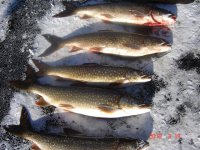Definitely try to go with a stainless table/top but have cutting boards either wood or preferably the white plastic which I believe is HDPE (High-density polyethylene . My dad was a butcher and this is the best way we always did it. My Aunt has a place on the Waupaca chain which we fished a lot and also always fished the white bass runs on the Wolf River (which we would have hundreds of fish to process daily). What he did was acquire a stainless table that we bought up there and used the plastic boards. Clean-up was easy with a simple wash-down of the stainless table and boards, sometimes we would place the board in the dish washer. the SS table has lasted decades and when the cuttings boards wore out we just replaced them which did not cost much. The SS table is costly up front (unless you find one in a auction or a business getting rid of one) but gives a great base that lasts for ever.
Just did a wiki search and found this what is below. Even with the blurb about plastic and "possible" sanitary issue we still found plastic to be have more pros than cons and I think I can say my dad was a pro with his experience and allways saw him work with plastic.
..from WIKI...
In choosing a cutting surface, there are pros and cons to each depending on application.
Wood
Wood has some advantages over plastic in that it is somewhat self healing; shallow cuts in the wood will close up on their own. Wood also has natural anti-septic properties.
Hardwoods with tightly grained wood and small pores are best for wooden cutting boards. Good hardness and tight grain helps reduce scoring of the cutting surface and absorption of liquid and dirt into the surface. Red oak for example, even though a hardwood, has large pores so it retains dirt, even after washing, making it a poor choice for cutting board material.
Wood boards need to be cared-for with mineral oil to avoid warping, and should not be left in puddles of liquid.
Care must be taken when selecting wood, especially tropical hardwood, for use as a cutting board as some species contain toxins or allergens.
Although technically a grass, laminated strips of bamboo also make an attractive and durable cutting board material.
Plastic
While plastic is theoretically a more sanitary material than wood for cutting boards, testing has shown this may not be the case. The softer surface of plastic boards is scored by knives, and the resulting grooves and cuts in the surface harbour bacteria even after being well washed. However, unlike wood, plastic boards do allow rinsing with harsher cleaning chemicals such as bleach and other disinfectants without damage to the board or retention of the chemicals to later contaminate food.
Plastic boards are usually called PE Cutting boards, PE being a shorthand for polyethylene the material which the boards are made of.
Semi-disposable thin flexible cutting boards also ease transferring their contents to a cooking or storage vessel.
Rubber
A recent trend has seen thick solid rubber pads used as cutting boards in the Sani-Tuff line popular in restaurant kitchens. They are about as expensive as well-made wood boards, they can take chemical disinfectants, and they are very heavy for their size, so they tend not to slip. Proponents claim remarkable self-healing properties, the same knife protection as good plastic or wood boards, and an inability to harbor significant amounts of moisture or bacteria.

![fishing 028 [640x480].JPG](/data/attachments/3/3148-271573c0d4127da1a0e1353916e17a1a.jpg)
![fishing 021 [640x480].JPG](/data/attachments/3/3149-40abecc43ebb223c8cc8d07f69ea4cd0.jpg)
![fishing 023 [640x480].JPG](/data/attachments/3/3150-eab297b17bb03672f29efa566b060448.jpg)
![muskie [640x480].jpg](/data/attachments/3/3151-f9c907417d284a1b3f444aa688c768e2.jpg)
